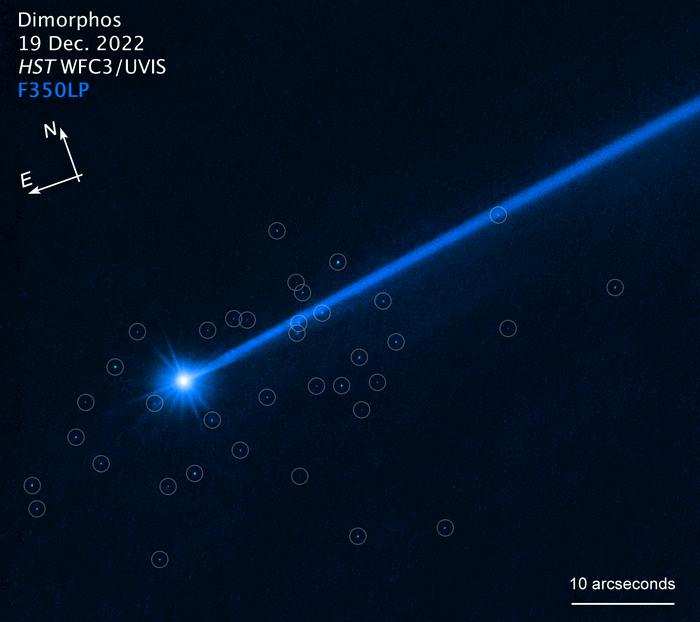
Sixty-five million years ago, the massive Chicxulub asteroid slammed into the Earth, obliterating most living animals, including all non-avian dinosaurs. To keep such a fate from happening to humans, NASA attempted to divert a benign asteroid last September with the Double Asteroid Redirection Test (DART). It was the world’s first planetary defense test.
DART was launched by a SpaceX Falcon 9 rocket from Vandenberg Air Force Base in northwestern California in November 2021. Once in orbit, the spacecraft separated from the Falcon 9 and cruised through space for about a year before encountering its target.
The experiment proved successful, knocking it off course. Now post-impact, Hubble Space Telescope observations have observed a swarm of boulders surrounding that asteroid, Dimorphos.

The test target, Dimorphos, is a moonlet asteroid, meaning it orbits a minor asteroid. It was 160 meters (525 feet) in diameter prior to impact and orbits the larger asteroid Didymos, measuring a much heftier 780 meters (0.48 miles) in diameter. Binary asteroids (two space rocks moving in tandem) are particularly interesting to scientists because they account for only about 15% of all spotted asteroids.
The 37 boulders were found to range in size from approximately one to seven meters (three to 22 feet) across and are gradually moving away from Dimorphos at a speed of just over half a mile per hour. However, the combined mass of the boulders represents only 0.1% of Dimorphos’s total mass.
David Jewitt from the University of California at Los Angeles, who is studying the asteroid’s post-impact changes, was pleased with the test results.
“This is a spectacular observation – much better than I expected,” he said. “We see a cloud of boulders carrying mass and energy away from the impact target. The numbers, sizes, and shapes of the boulders are consistent with them having been knocked off the surface of Dimorphos by the impact. This tells us for the first time what happens when you hit an asteroid and see material coming out up to the largest sizes. The boulders are some of the faintest things ever imaged inside our Solar System.”
Jewitt said the impact shook off 2% of the asteroid’s surface boulders.
“The boulders could have been excavated from a circle about 160 feet across (the width of an American football field) on the surface of Dimorphos,” he said.
Astronomers are still unsure about the origins of Dimorphos. One speculation is that the smaller moonlet may have formed long ago from material ejected into space by the larger asteroid Didymos. The parent body could have spun up too quickly or lost material due to a glancing collision with another object.
Dimorphos would have formed gravitationally by the ejected material, creating a ring. This would result in a flying rubble pile of rocky debris held together by a relatively weak gravitational pull. As a result, the interior is likely not solid but rather has a weak, pebbly structure.
It is unknown how the boulders were lifted from the asteroid’s surface. They could have been part of an ejecta plume that Hubble and other observatories captured. Or, like hitting a bell with a hammer, a seismic wave from the impact could have rattled through the asteroid, shaking away the surface rubble.
Scientists will know more in late 2026 when the European Space Agency’s upcoming Hera spacecraft arrives at the scene. Hera will perform a detailed post-impact survey and reveal more information.
Jewitt says the boulder cloud will still be dispersing when Hera arrives.
It’s like a very slowly expanding swarm of bees that eventually will spread along the binary pair’s orbit around the Sun...If we follow the boulders in future Hubble observations, then we may have enough data to pin down the boulders’ precise trajectories. And then we’ll see in which directions they were launched from the surface.”






